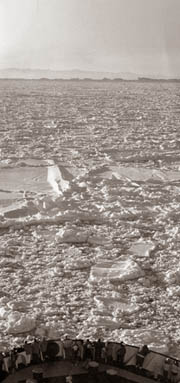
The long view from Antarctica
In 1903, when the Eiffel Tower was still the tallest building in the
world, Mark Twain used its soaring height to give us one of the most
brilliant analogies (comparisons) for human kind's place on the planet.
"If the Eiffel Tower were now representing the world's age," he wrote
in his essay, 'Was the World Made for Man?' then "the skin of paint on
the pinnacle-knob at its summit would represent man's share of that
age."
Since then, we've come up with taller stuff - the Chrysler Building,
the Petronas Towers, Taipei 101; but in geological terms, it doesn't
change the fact that humanity's entire existence amounts to nothing more
than a blink of the eye.

On a recent trip to Antarctica, a Canadian geologist friend of mine,
Fred Roots, one-upped Twain's Eiffel Tower analogy. According to Fred,
who among other accolades has a mountain range in Antarctica named after
him, we aren't even the skin of paint on the summit of the Eiffel Tower;
more like a stray dropping on top from a pigeon who happened to be
flying by. Ouch!
Antarctica will do that to you. It will make you wonder about
beginnings and endings: gases coagulating (clotting), continents
shifting, oceans churning, suns exploding. Perhaps because it is the
most extreme place on this planet, and has never nurtured or sustained
any human civilization.
Perhaps because it is free of such markers as towers of iron,
pyramids, trees; chances are, when you first catch sight of the
continent, you'll be forced to think about what the earth was like
before humans came along.
Antarctica embodies all that is prehistory; Continental crust,
cordilleran folds, pre-Cambrian granite shields; trenches, plates,
rifts. Trapped in the layers of ice cores, are bubbles of air that have
kept a careful record of climate changes over the ages. From these we
can derive clues to the extinction and evolutionary processes that have
preceded us.
Then, there's the scale. Where else can you find the largest recorded
mammal, the blue whale, co-existing with a tiny mite growing on a
century-old plant? Penguin colonies that number in millions; nights that
run into days, and days that run into nights; katabatic winds that
scream down the ice sheets at a terrifying 180 miles per hour, and then
remain equally terrifyingly still.
That Antarctica is the last bastion of nature in her most
uninterrupted glory, is unquestionable. And that nature is the only
lasting basis for any civilization's success and survival, is something
our history has repeatedly proved to us. Preserving Antarctica,
therefore, seems like a smart thing to do. Because, while it has no
indigenous people, it is still in the best position to predict the
future of our species; tell us where we're going to end up if we
continue to go the way we're going.
Here's the other thing: everything connects. If the present Antarctic
ice sheet were to melt, it would raise the levels of the oceans by 200
feet.
By the end of March, close to 30,000 people would have visited
Antarctica this summer alone. People like me, curious, adventurous,
knowing little about the rocks and waves, the wind and air and ice.
Thirty-thousand people who would have impacted the fragile ecosystem,
who might have grabbed a pebble here and there, stomped on a lichen,
dropped an Evian bottle overboard by mistake, abducted a penguin.
Even if tourists did none of that, they would still have contributed
to fuel emissions and disrupted the normal cycle of life.
Despite repeated warnings from the scientific community about the
delicate balance that needs to be maintained in Antarctica, under the
Antarctic Treaty, there are no formal measures or legally binding
regulations on commercial tourism.
This means, large cruise ships carrying 1,000 passengers can continue
to sail in, North America can continue to build its access road from
McMurdo base to the South Pole, and Japan can continue to send whaling
fleets on the pretext of "environmental research."
Meanwhile, Antarctica continues to record what it can in the air
bubbles trapped between the layers of its evershifting sheets of ice.
The danger is that we may not be around to make sense of these records.
"To lose our tranquillity," Twain wrote, "will not hurry geology;
nothing hurries geology."
Perhaps Time will tell after all. But it seems a terrible shame to be
standing where we are - at such a lofty pinnacle - refusing to
acknowledge the long view that lies before us.
International Herald Tribune |


